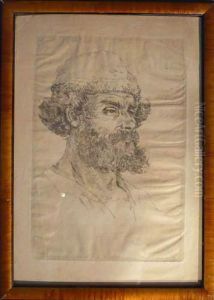Jean-Michel, Michel Cazin Paintings
Jean-Michel Cazin, born on May 25, 1869, in Samer, France, was a distinguished French artist known for his versatile engagement with art, straddling painting, ceramics, and sculpture throughout his career. Son of the well-known ceramicist Jean-Charles Cazin, Jean-Michel was immersed in an artistic environment from an early age, which significantly influenced his career path. His artistic lineage provided him with a deep understanding of art's various forms and materials, setting the stage for his experimental and diverse body of work. Cazin's upbringing in a household centered around artistic creation instilled in him a profound appreciation for the arts, which he would carry throughout his life.
Cazin's education and early career were marked by traditional training, yet he quickly developed a distinctive style that set him apart from his contemporaries. He was primarily known for his innovative work in ceramics and his ability to infuse traditional techniques with modern sensibilities. His contributions to the art of ceramics were particularly noteworthy, with his pieces often reflecting a unique blend of form, color, and texture, pushing the boundaries of what was traditionally expected in ceramic art.
Beyond ceramics, Cazin was also an accomplished painter and sculptor, demonstrating a remarkable versatility across mediums. His paintings and sculptures often explored themes of nature, human emotion, and the complexities of the human condition, characterized by a sensitivity to form and a nuanced use of color. Despite the diversity of his work, a coherent aesthetic philosophy tied his oeuvre together, marked by an ongoing exploration of the relationship between material, form, and meaning.
Jean-Michel Cazin's contribution to the arts was cut short by his untimely death on March 19, 1917, during World War I. His legacy, however, lives on through his innovative works and the influence he had on subsequent generations of artists. Cazin's ability to transcend the traditional boundaries of art, experimenting with different materials and forms, has made him a significant figure in the history of French art. His work continues to be celebrated for its originality, depth, and the unique vision of beauty it conveyed.
 ">
"> ">
">
